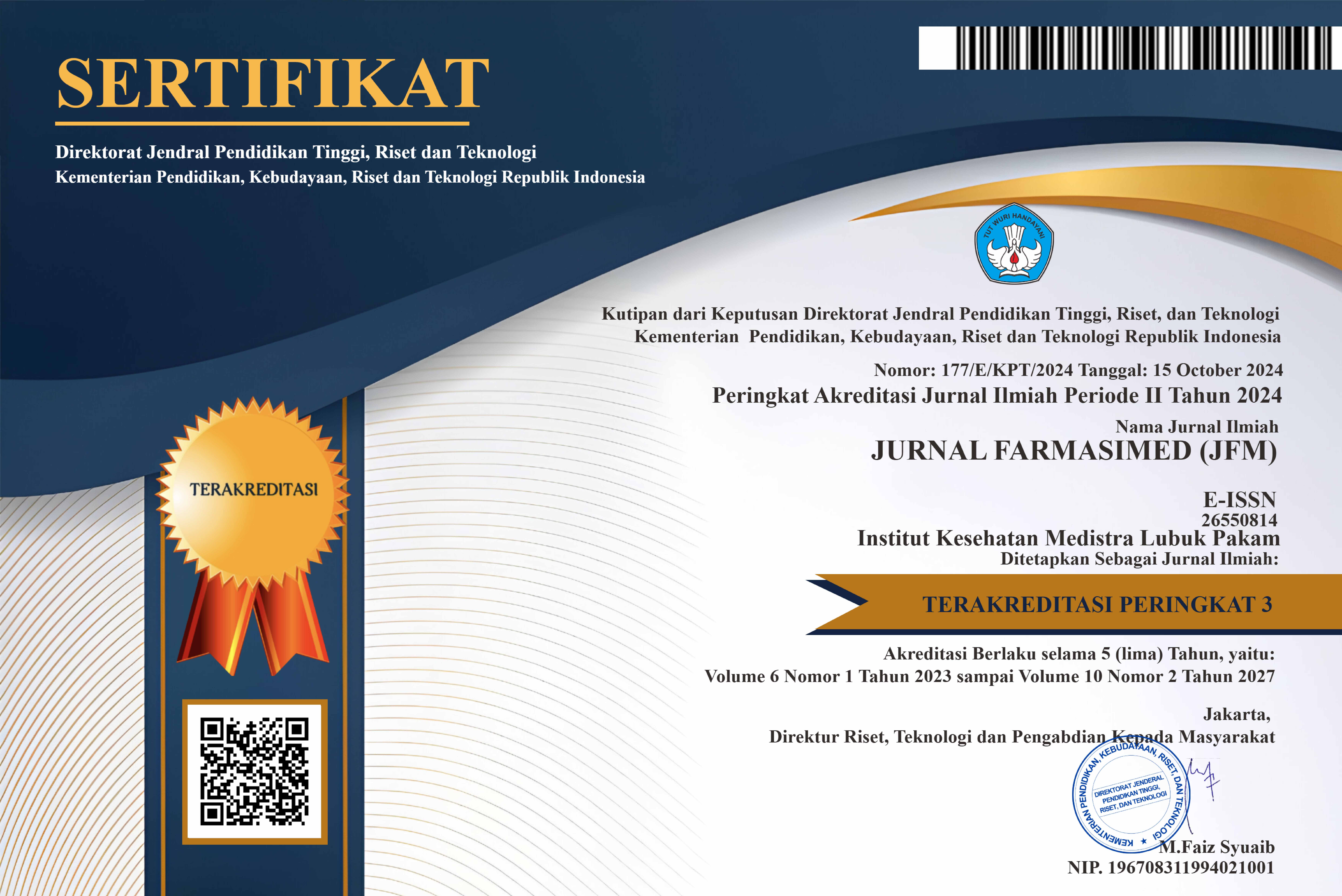KINETICS OF PIROXICAM RELEASE THROUGH IONTOPHORESIS AT VARIOUS PHS FROM POLYELECTROLYTE HYDROGELS WITH SODIUM ALGINATE-TRAGACANTH GUM POLYMER
DOI:
https://doi.org/10.35451/jfm.v6i1.1904Keywords:
Difusi, Fluks, Pelepasan obat, Kinetika PelepasanAbstract
Piroxicam is a non-steroidal anti-inflammatory drug (NSAID) used to treat symptoms of osteoarthritis and rheumatoid arthritis. This drug can irritate the stomach as a side effect of oral administration. One strategy to overcome these side effects is transdermal delivery in polyelectrolyte hydrogel with iontophoresis. This research aims to study the pH-varying effect of polyelectrolyte hydrogel on piroxicam release from hydrogel via iontophoresis using a Franz diffusion cell. The formulation was made with pH variations, namely 4.2 (F1), 5.5 (F2), 6.4 (F3), and 7.4 (F4). Evaluations include organoleptics, pH, homogeneity, spreadability, viscosity, flow properties, conductivity, and diffusion tests. The polyelectrolyte hydrogel obtained was yellow and homogeneous with a pH variation of 4.2 ± 0.02 to 7.42±0.02, spreadability of 4.22±0.21 cm to 4.35±0.28 cm, viscosity 47,378 cps to 59,297 cps; flow properties include thixotropic plasticity; and conductivity 8.01±0.78 ms/cm to 9.58±1.00 ms/cm. Moreover, piroxicam was released from the hydrogel assisted by DC-type iontophoresis with flux values of 634.52 ?g/cm2 (F1), 427.91 ?g/cm2 (F2), 205.76 ?g/cm2 (F3), and 253.56 ?g/cm2 (F4). Statistical analysis showed that decreasing pH had a significant effect (sig<0.05) on increasing piroxicam release from hydrogel based on flux value. The release kinetic behavior of all formulas (F1-F4) does not show the same type of kinetic model based on the correlation coefficient value approach, which is closest to 1.
Keywords: Diffusion, flux, drug release, release kinetics.
Downloads
References
Agnihotri, S. A., Kulkarni, R. V., Mallikarjuna, N. N., Kulkarni, P. V., & Aminabhavi, T. M. (2005). Electrically modulated transport of diclofenac salts through hydrogels of sodium alginate, carbopol, and their blend polymers. Journal of Applied Polymer Science, 96(2), 301–311. https://doi.org/10.1002/app.21398
Basan, H., Göer, N. G., Erta?, N., & Orbey, M. T. (2001). Quantitative determination of piroxicam in a new formulation (piroxicam-?-cyclodextrin) by derivative UV spectrophotometric method and HPLC. Journal of Pharmaceutical and Biomedical Analysis, 26(2), 171–178. https://doi.org/10.1016/S0731-7085(01)00383-1
Chughtai, M., Mustafa, S., & Mumtaz, M. (2014). Study of Physicochemical Parameters of Rainwater: A Case Study of Karachi, Pakistan. American Journal of Analytical Chemistry, 05(04), 235–242. https://doi.org/10.4236/ajac.2014.54029
Cikrikci, S., Oztop, M. H., & Mert, B. (2018). Functional Structure / Activity Relationships Development of pH sensitive alginate / gum tragacanth based hydrogels for oral insulin delivery Corresponding author?: https://doi.org/10.1021/acs.jafc.8b02525
Depkes RI. (2020). Farmakope Indonesia edisi VI. In Departemen Kesehatan Republik Indonesia.
Gao, F., Reitz, F. B., & Pollack, G. H. (2003). Potentials in anionic polyelectrolyte hydrogels. Journal of Applied Polymer Science, 89(5), 1319–1321. https://doi.org/10.1002/app.12283
Garg, A. D., Aggarwal, S., Garg, & Sigla, A. K. (2002). Spreading of Semimolid Formulation. Pharmaceutical Tecnology, 85–102.
Garg, V., Singh, H., Singh, B., & Beg, S. (2016). Systematic Development of Transethosomal Gel System of Piroxicam?: Formulation Optimization , In Vitro Evaluation , and Ex Vivo Assessment. AAPS PharmSciTech. https://doi.org/10.1208/s12249-016-0489-z
Indrawati, A., & Tanti, D. A. (2017). Pengukuran pH dan Konduktivitas Air Hujan untuk Pemantauan Kualitas Udara di Daerah bandung. Berita Dirgantara, 18(2), 53–60.
Kalam, M., Humayun, M., Parvez, N., & Yadav, S. (2007). Release Kinetics of Modified Pharmaceutical Dosage Forms: a Review. Continental J. Pharmaceutical Sciences, 1(January), 30–35.
Khunt, D. M., Mishra, A. D., & Shah, D. R. (2012). Formulation design & development of piroxicam emulgel. International Journal of PharmTech Research, 4(3), 1332–1344.
Kwon, H. J., Yasuda, K., Gong, J. P., & Ohmiya, Y. (2014). Polyelectrolyte Hydrogels for Replacement and Regeneration of Biological Tissues. 22(3), 227–235. https://doi.org/10.1007/s13233-014-2045-6
Lucida, H., Husni, P., & Hosina, V. (2013). Kinetika permeasi klotrimazol dari matriks basis krim yang mengandung. J. Ris. Kim., 2(1), 14–20.
Meka, V. S., Sing, M. K. G., Pichika, M. R., Nali, S. R., Kolapalli, V. R. M., & Kesharwani, P. (2017). A comprehensive review on polyelectrolyte complexes. Drug Discovery Today, 22(11), 1697–1706. https://doi.org/10.1016/j.drudis.2017.06.008
Melinda, F., Laili, S., & Syauqi, A. (2017). Uji Kualitas Air Minum Isi Ulang pada Depo Air Minum Di Sekitar Kampus UNISMA Malang. Biosaintropis (Bioscience-Tropic), 3(1), 53–59.
Merino, V., & López, A. (2010). Transdermal Iontophoresis. Current Technologies to Increase the Transdermal Delivery of Drugs, 41–52. https://doi.org/10.2174/978160805191511001010041
Nining, N., Radjab, N. S., & Kholifah, N. (2019). Kombinasi Trietanolamin Stearat dan Setil Alkohol dalam Stabilitas Fisik Krim M/A Ekstrak Psidium guajava L. SCIENTIA Jurnal Farmasi Dan Kesehatan, 9(1), 17–23. https://doi.org/10.1111/plb.12626
Nining, N., Radjab, N. S., & Sulistiyaningrum, W. (2019). Stabilitas Fisik Krim M/A Ekstrak Buah Jambu Biji (Psidium guajava L .) dengan Variasi Setil Alkohol sebagai Stiffening Agent. Journal of Current Pharmaceutical Sciences (JCPS), 2(2), 142–147.
Roudhatini. (2013). Formulasi Sediaan Gel Hand Sanitizer Minyak Atsiri Pala (Myristica fragransHoutt.)?: Uji Stabilitas Fisik Dan Uji Aktivitas Antibakteri Terhadap Bakteri Staphylococcus aureus. Publikasi Ilmiah.
Rowe, R. C., Sheskey, P. J., & Quinn, M. E. (2009). Handbook of Pharmaceutical Excipients 6th Edition. In Pharmaceutical Press and the American Pharmacist Association, USA.
Rukmana, N. F. (2016). Identifikasi Pengaruh pH Terhadap Sifat Reologi Polimer (Karbopol 940, Xanthan Gum, Na CMC, Na Alginat dan Tragakan) Tunggal dan Kombinasi.
Shohin, I. E., Kulinich, J. I., Ramenskaya, G. V., Abrahamsson, B., Kopp, S., Langguth, P., Polli, J. E., Shah, V. P., Groot, D. W., Barends, D. M., & Dressman, J. B. (2014). Biowaiver monographs for immediate release solid oral dosage forms: Piroxicam. Journal of Pharmaceutical Sciences, 103(2), 367–377. https://doi.org/10.1002/jps.23799
Sinko, P. J., & Singh, Y. (Eds.). (2011). Martin’s physical pharmacy and pharmaceutical sciences 6th edition (Sixth edit). Wolter Kluwer Health.
Tavakoli, N., Minaiyan, M., Heshmatipour, M., & Musavinasab, R. (2015). Transdermal iontophoretic delivery of celecoxib from gel formulation. Research in Pharmaceutical Sciences, 10(5), 419–428.
Wang, Y., Zeng, L., Song, W., & Liu, J. (2021). Influencing factors and drug application of iontophoresis in transdermal drug delivery?: an overview of recent progress. Drug Delivery and Translational Research, 0123456789. https://doi.org/10.1007/s13346-021-00898-6
Yati, K., Jufri, M., Gozan, M., & Dwita, L. P. (2018). The Effect of Hidroxy Propyl Methyl Cellulose (HPMC) Concentration Variation on Physical Stability of Tobacco (Nicotiana tabaccum L.) Extract Gel and Its Activity Against Streptococcus mutans. Pharmaceutical Sciences and Research (PSR), 5(3), 133–141. https://doi.org/10.7454/psr.v5i3.4146
Zuo, J., Du, L., Li, M., Liu, B., Zhu, W., & Jin, Y. (2014). Transdermal enhancement effect and mechanism of iontophoresis for non-steroidal anti-in fl ammatory drugs. Elsevier B.V., 466(1–2), 76–82. https://doi.org/10.1016/j.ijpharm.2014.03.013
Downloads
Published
Issue
Section
License
Copyright (c) 2023 Nining Nining

This work is licensed under a Creative Commons Attribution 4.0 International License.
Copyright in each article is the property of the Author.

























